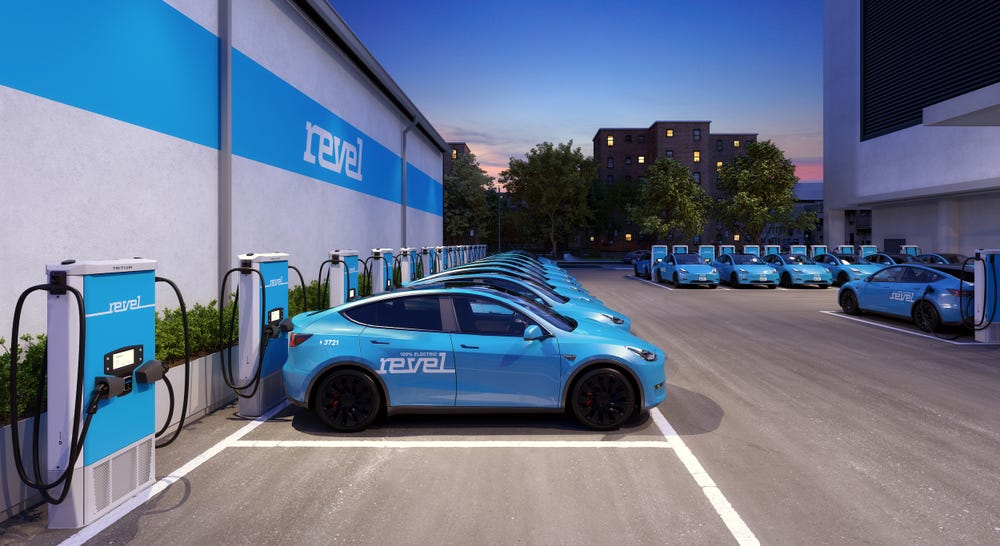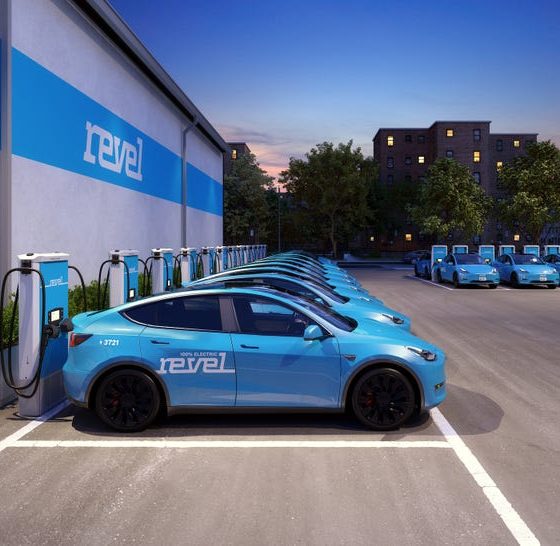Revel, a New York City-based ridesharing company, will launch its fleet of Tesla Model Y taxis in the Big Apple in early August after a mix-up with NYC’s regulatory agency, the Taxi and Limousine Commission (TLC).
The approval and soon-to-be-launched fleet of Model Y taxis will hit New York City streets on August 2nd, according to Revel executives.
In mid-June, it was reported by several news media outlets that the NYC TLC had successfully blocked the inclusion of Revel’s Tesla Model Y taxis citing a stoppage on issuing new-for-hire taxi licenses for electric cars. However, the story was blown widely out of proportion through what TLC Spokesperson Allan Fromberg called, “a giant game of telephone.” In reality, the City placed a capacity limitation on the number of approved taxi licenses in 2018, halting the issuance of new taxi licenses for all vehicles, not just electric ones.
Tesla Model 3 wins hearts as famed NYC Taxi, picks up where Nissan Leaf couldn’t
Cries of conspiracy floated through the EV community, failing to accept the unfortunate verdict that was placed upon Revel’s all-electric, sustainable fleet of taxi cabs donning the notorious Tesla “T.” However, the TLC has granted Revel 49 licenses, according to Fromberg, covering all but one vehicle in the company’s Model Y fleet.
Of the 49, fifteen have been inspected and approved for operation as early as next week. The New York Daily News, who initially covered the story, said 35 others will roll out when they are inspected and approved for ride-hailing services. The fleet will operate south of 42nd St. in Manhattan, stretching down to the tip of the island. Revel told Teslarati that it will consider growing into other neighborhoods and boroughs once the company has more of an idea of where the fleet is being utilized most frequently.
The company will also open a Superhub in Bed-Stuy, Brooklyn with 25 Level 3 chargers. This will make it the largest universal fast charging depot in the Americas, the company said.
The addition of Revel’s 49 Model Ys broadens New York City’s small fleet of electrified taxis. 120,000 licensed vehicles already navigate through the City’s five boroughs, and there is not room for many more cars. However, the TLC is fully supportive of a transition to electrification, and it expects several agencies to make a more conscious effort toward introducing electric powertrains in the coming years. “The TLC is fully committed to a 100% electrified future, just not at the cost of additional congestion,” Fromberg told Teslarati.
For Revel, it has been a long and drawn-out process. The company’s attempts to gain licenses for its Model Y fleet started in March. After the five-to-one vote that approved the banishment of the EV exemption for taxis, Revel’s already-submitted applications were ultimately approved. A company spokesperson told Tesarati that Revel did not anticipate the approval of the licenses.
Fromberg, who has been the TLC’s Deputy Chief of Public Relations for several years, said that the agency was legally required to review and process Revel’s applications because they were submitted prior to June 25th, three days after the vote took place. “Revel applied for a Base License in the late Spring and submitted applications for electric cars ahead of the June 22nd vote. The Yellow Taxi market is rebounding and ridership has increased steadily since the City’s reopening,” Fromberg told us.
Revel CEO Frank Reig said, “The initial response from the public has been overwhelming, and we can’t wait to start serving New Yorkers who care as much about the City’s future as we do. With our all-electric rideshare fleet and fast-charging Superhub network, we’re investing in a zero-carbon transportation future. We’d like to thank Commissioner Jarmoszuk and the TLC for supporting New York City’s climate goals, and working with us to get the city’s first all-electric, all-employee driven fleet on the road.”
Don’t hesitate to contact us with tips! Email us at tips@teslarati.com, or you can email me directly at joey@teslarati.com.

News
Tesla starts showing how FSD will change lives in Europe
Local officials tested the system on narrow country roads and were impressed by FSD’s smooth, human-like driving, with some calling the service a game-changer for everyday life in areas that are far from urban centers.

Tesla has launched Europe’s first public shuttle service using Full Self-Driving (Supervised) in the rural Eifelkreis Bitburg-Prüm region of Germany, demonstrating how the technology can restore independence and mobility for people who struggle with limited transport options.
Local officials tested the system on narrow country roads and were impressed by FSD’s smooth, human-like driving, with some calling the service a game-changer for everyday life in areas that are far from urban centers.
Officials see real impact on rural residents
Arzfeld Mayor Johannes Kuhl and District Administrator Andreas Kruppert personally tested the Tesla shuttle service. This allowed them to see just how well FSD navigated winding lanes and rural roads confidently. Kruppert said, “Autonomous driving sounds like science fiction to many, but we simply see here that it works totally well in rural regions too.” Kuhl, for his part, also noted that FSD “feels like a very experienced driver.”
The pilot complements the area’s “Citizen Bus” program, which provides on-demand rides for elderly residents who can no longer drive themselves. Tesla Europe shared a video of a demonstration of the service, highlighting how FSD gives people their freedom back, even in places where public transport is not as prevalent.
What the Ministry for Economic Affairs and Transport says
Rhineland-Palatinate’s Minister Daniela Schmitt supported the project, praising the collaboration that made this “first of its kind in Europe” possible. As per the ministry, the rural rollout for the service shows FSD’s potential beyond major cities, and it delivers tangible benefits like grocery runs, doctor visits, and social connections for isolated residents.
“Reliable and flexible mobility is especially vital in rural areas. With the launch of a shuttle service using self-driving vehicles (FSD supervised) by Tesla in the Eifelkreis Bitburg-Prüm, an innovative pilot project is now getting underway that complements local community bus services. It is the first project of its kind in Europe.
“The result is a real gain for rural mobility: greater accessibility, more flexibility and tangible benefits for everyday life. A strong signal for innovation, cooperation and future-oriented mobility beyond urban centers,” the ministry wrote in a LinkedIn post.
News
Tesla China quietly posts Robotaxi-related job listing
Tesla China is currently seeking a Low Voltage Electrical Engineer to work on circuit board design for the company’s autonomous vehicles.

Tesla has posted a new job listing in Shanghai explicitly tied to its Robotaxi program, fueling speculation that the company is preparing to launch its dedicated autonomous ride-hailing service in China.
As noted in the listing, Tesla China is currently seeking a Low Voltage Electrical Engineer to work on circuit board design for the company’s autonomous vehicles.
Robotaxi-specific role
The listing, which was shared on social media platform X by industry watcher @tslaming, suggested that Tesla China is looking to fill the role urgently. The job listing itself specifically mentions that the person hired for the role will be working on the Low Voltage Hardware team, which would design the circuit boards that would serve as the nervous system of the Robotaxi.
Key tasks for the role, as indicated in the job listing, include collaboration with PCB layout, firmware, mechanical, program management, and validation teams, among other responsibilities. The role is based in Shanghai.
China Robotaxi launch
China represents a massive potential market for robotaxis, with its dense urban centers and supportive policies in select cities. Tesla has limited permission to roll out FSD in the country, though despite this, its vehicles have been hailed as among the best in the market when it comes to autonomous features. So far, at least, it appears that China supports Tesla’s FSD and Robotaxi rollout.
This was hinted at in November, when Tesla brought the Cybercab to the 8th China International Import Expo (CIIE) in Shanghai, marking the first time that the autonomous two-seater was brought to the Asia-Pacific region. The vehicle, despite not having a release date in China, received a significant amount of interest among the event’s attendees.
Elon Musk
Elon Musk and Tesla AI Director share insights after empty driver seat Robotaxi rides
The executives’ unoccupied tests hint at the rapid progress of Tesla’s unsupervised Robotaxi efforts.

Tesla CEO Elon Musk and AI Director Ashok Elluswamy celebrated Christmas Eve by sharing personal experiences with Robotaxi vehicles that had no safety monitor or occupant in the driver’s seat. Musk described the system’s “perfect driving” around Austin, while Elluswamy posted video from the back seat, calling it “an amazing experience.”
The executives’ unoccupied tests hint at the rapid progress of Tesla’s unsupervised Robotaxi efforts.
Elon and Ashok’s firsthand Robotaxi insights
Prior to Musk and the Tesla AI Director’s posts, sightings of unmanned Teslas navigating public roads were widely shared on social media. One such vehicle was spotted in Austin, Texas, which Elon Musk acknowleged by stating that “Testing is underway with no occupants in the car.”
Based on his Christmas Eve post, Musk seemed to have tested an unmanned Tesla himself. “A Tesla with no safety monitor in the car and me sitting in the passenger seat took me all around Austin on Sunday with perfect driving,” Musk wrote in his post.
Elluswamy responded with a 2-minute video showing himself in the rear of an unmanned Tesla. The video featured the vehicle’s empty front seats, as well as its smooth handling through real-world traffic. He captioned his video with the words, “It’s an amazing experience!”
Towards Unsupervised operations
During an xAI Hackathon earlier this month, Elon Musk mentioned that Tesla owed be removing Safety Monitors from its Robotaxis in Austin in just three weeks. “Unsupervised is pretty much solved at this point. So there will be Tesla Robotaxis operating in Austin with no one in them. Not even anyone in the passenger seat in about three weeks,” he said. Musk echoed similar estimates at the 2025 Annual Shareholder Meeting and the Q3 2025 earnings call.
Considering the insights that were posted Musk and Elluswamy, it does appear that Tesla is working hard towards operating its Robotaxis with no safety monitors. This is quite impressive considering that the service was launched just earlier this year.










